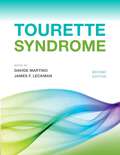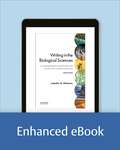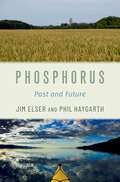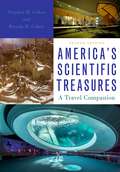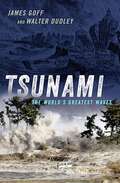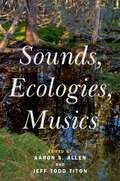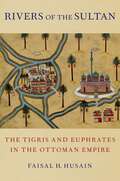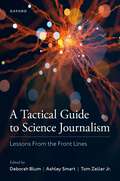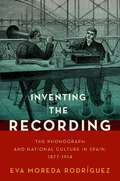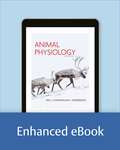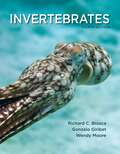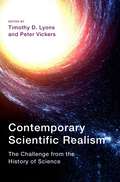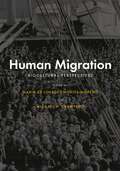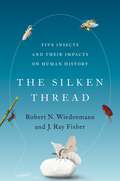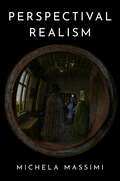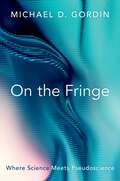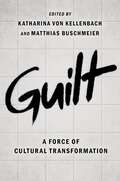- Table View
- List View
Tourette Syndrome
by Davide Martino James LeckmanTourette syndrome (TS) has become increasingly recognised within society and has gained scientific interest worldwide. Knowledge of its clinical presentation, mechanisms of disease, and available treatment approaches has increased remarkably over the last two decades. Likewise, the way clinicians, teachers, social care workers, and families face the problems manifested by patients with TS is rapidly evolving. Tourette Syndrome, edited by Davide Martino and James F. Leckman, offers a unique opportunity to capture this knowledge advance through a comprehensive and up-to-date overview. Tourette Syndrome covers all the main aspects related to TS, analyzing its complex clinical presentation, the novel viewpoints of causes and mechanisms, state-of-the-art assessment techniques, and the diversity of treatment options. Multidisciplinarity is the main asset of this volume, which represents a source of consultation for a wide audience of professionals, integrated with video tutorials related to particularly complex areas of patient management. Medical and PhD students, as well as post-doctoral scientists, will be able to use the volume as a valuable learning source.
Writing in the Biological Sciences
by Angie Hofmann"Writing in the Biological Sciences: A Comprehensive Guide to Scientific Communication" serves as a comprehensive "one-stop" reference guide to scientific writing and communication for budding professionals in the life sciences and related fields. The book is designed to function both as a free-standing textbook for a course on writing in the sciences and as an accompanying text or reference guide in courses with writing-intensive components. It covers all the basics of scientific communication that students need to know and master for successful scientific careers. The book lays the foundation for professional writing by starting with basic scientific writing principles and then by applying these principles to lab reports, summaries, and critiques and eventually also to full-fledged scientific research articles, review articles, and grant proposals. Practical advice for organizing academic presentations and posters as well as for putting together job applications is also included.
Phosphorus: Past and Future
by Jim Elser Phil HaygarthPhosphorus is essential to the production of our food, and it also triggers algal blooms in lakes, rivers, and oceans when it slips through our hands. An understanding of this essential resource and how we have used and misused it over the years is crucial to the sustainability of our well-being on our planet. In this book, world authorities on phosphorus sustainability Jim Elser and Phil Haygarth explain this element's involvement in biology, human health and nutrition, food production, ecosystem function, and environmental sustainability. Phosphorus chronicles the sustainability challenges phosphorus both poses and solves in various contexts. The book begins with its discovery over 350 years ago, moving to its basic chemistry and the essential role it plays in all living things on Earth. Chapters go on to explain the rise in the usage of phosphorus in agriculture and how the increase in the mining of rock phosphate in the mid-20th century was essential for the Green Revolution. However, phosphorus emissions from human wastes and detergents triggered widespread algal blooms in the 1960s and 1970s. While such emissions have been brought under better control with wastewater treatment, diffuse emissions from farming continue to cause water quality degradation. The authors explain how these diffuse phosphorus emissions may worsen with climate change. In ten concise chapters, Elser and Haygarth offer engaging explanations of our historical use and abuse of phosphorus, including the phosphorus sustainability movement and new efforts to sustain food benefits of limited rock reserves following the phosphate rock price shock in 2007-2008. Highlighting new approaches for phosphorus, the two "Systems Innovators" turn toward the emerging set of sustainable phosphorus solutions necessary to achieve a sustainable "phosphoheaven" and avoid "phosphogeddon." The book provides an insider's take on this essential resource and why all of us need to wrestle with the wicked problems this element will cause, illuminate, or eliminate in years to come.
America's Scientific Treasures: A Travel Companion
by Stephen M. Cohen Brenda H. CohenWhether you are planning a road trip or looking to engage with history from the comfort of your couch, the second edition of America's Scientific Treasures is sure to satisfy your craving for scientific and technologic history. Stephen M. Cohen and Brenda H. Cohen, a mother-son pair, take readers through countless museums, arboretums, zoos, national parks, planetariums, natural and technological sites, and the homes of a few scientists in this exciting volume. The two combine their expertise in chemistry and history, making this an educational travel guide for science and technology enthusiasts. The book is split into nine geographic regions and organized by state, and it includes how to get to each place, whom to contact, whether it is handicapped-accessible, and even where you can grab a bite to eat nearby. Cohen and Cohen provide the history and significance of each location, plus they offer images for notable locations like the African Savanna at the San Francisco Zoo & Gardens and the Smithsonian Arctic Studies Center in the Anchorage Museum. The resulting book is a navigable travel guide perfect for any science or technology enthusiast. So, what are you waiting for? Let's take a journey through the history of American sciences and engineering.
Tsunami: The World's Greatest Waves
by James Goff Walter DudleyEvery year that passes without a tsunami means that we're just that much closer to our next one. What can we do to ensure we're prepared when the next catastrophic tsunami strikes? The ferocious waves of a tsunami can travel across oceans at the speed of a jet airplane. They can kill families, destroy entire cultures, and even gut nations. To understand these beasts in our waters well enough to survive them, we must understand how they're created and learn from the past. In this book, tsunami specialists James Goff and Walter Dudley arm readers with everything they need to survive a tsunami and maybe even avoid the next one. The book takes readers on a historical journey through some of the most devastating tsunamis in human history, some of the quirky ones, and even some that may not even be what most of us think of as tsunamis. Diving into personal and scientific stories of disasters, Tsunami pulls readers into the many ways these waves can be generated, ranging from earthquakes and volcanic eruptions to explosions, landslides, and beyond. The book provides overviews of some of the great historical events - the 1755 Lisbon, 1946 Aleutian, 1960 Chile, and 2004 Indian Ocean tsunamis, but also some of the less well-known as well such as the 1958 Lituya Bay, 563 CE Lake Geneva, a 6,000 year old Papua New Guinean mystery, and even a 2.5 Million year old asteroid. This is not straight science, though. Each event is brought to life in a variety of ways through stories of survival, human folly, and echoes of past disasters etched in oral traditions and the environment. The book combines research from oceanography, biogeography, geology, history, archaeology and more, with data collected from over 400 survivor interviews. Alongside carefully selected images and the scientific measurements of these tsunamis, the book offers tales of survival, heroism, and tragic loss. Through a balanced combination of personal experience, the Earth's changing environment, tales of tragedy, and a recount of oral traditions, Tsunami allows readers to engage with a new scientific approach to these overwhelming waves. The resulting book unveils the science of disaster like never before.
Tsunami: The World's Greatest Waves
by James Goff Walter DudleyEvery year that passes without a tsunami means that we're just that much closer to our next one. What can we do to ensure we're prepared when the next catastrophic tsunami strikes? The ferocious waves of a tsunami can travel across oceans at the speed of a jet airplane. They can kill families, destroy entire cultures, and even gut nations. To understand these beasts in our waters well enough to survive them, we must understand how they're created and learn from the past. In this book, tsunami specialists James Goff and Walter Dudley arm readers with everything they need to survive a tsunami and maybe even avoid the next one. The book takes readers on a historical journey through some of the most devastating tsunamis in human history, some of the quirky ones, and even some that may not even be what most of us think of as tsunamis. Diving into personal and scientific stories of disasters, Tsunami pulls readers into the many ways these waves can be generated, ranging from earthquakes and volcanic eruptions to explosions, landslides, and beyond. The book provides overviews of some of the great historical events - the 1755 Lisbon, 1946 Aleutian, 1960 Chile, and 2004 Indian Ocean tsunamis, but also some of the less well-known as well such as the 1958 Lituya Bay, 563 CE Lake Geneva, a 6,000 year old Papua New Guinean mystery, and even a 2.5 Million year old asteroid. This is not straight science, though. Each event is brought to life in a variety of ways through stories of survival, human folly, and echoes of past disasters etched in oral traditions and the environment. The book combines research from oceanography, biogeography, geology, history, archaeology and more, with data collected from over 400 survivor interviews. Alongside carefully selected images and the scientific measurements of these tsunamis, the book offers tales of survival, heroism, and tragic loss. Through a balanced combination of personal experience, the Earth's changing environment, tales of tragedy, and a recount of oral traditions, Tsunami allows readers to engage with a new scientific approach to these overwhelming waves. The resulting book unveils the science of disaster like never before.
Sounds, Ecologies, Musics
Sounds, Ecologies, Musics poses exciting challenges and provides fresh opportunities for scholars, scientists, environmental activists, musicians, and listeners to consider music and sound from ecological standpoints. Authors in Part I examine the natural and built environment and how music and sound are woven into it, how the environment enables music and sound, and how the natural and cultural production of music and sound in turn impact the environment. In Part II, contributors consider music and sound in relation to ecological knowledges that appear to conflict with, yet may be viewed as complementary to, Western science: traditional and Indigenous ecological and environmental knowledges. Part III features multidisciplinary and interdisciplinary approaches by scholars, scientists, and practitioners who probe the ecological imaginary regarding the complex ideas and contested keywords that characterize ecomusicology: sound, music, culture, society, environment, and nature. A common theme across the book is the idea of diverse ecologies. Once confined to the natural sciences, the word "ecology" is common today in the social sciences, humanities, and arts - yet its diverse uses have become imprecise and confusing. Engaging the conflicting and complementary meanings of "ecology" requires embracing a both/and approach. Diverse ecologies are illustrated in the methodological, terminological, and topical variety of the chapters as well as the contributors' choice of sources and their disciplinary backgrounds. In times of mounting human and planetary crises, Sounds, Ecologies, Musics challenges disciplinarity and broadens the interdisciplinary field of ecomusicologies. These theoretical and practical studies expand sonic, scholarly, and political activism from the diversity-equity-inclusion agenda of social justice to embrace the more diverse and inclusive agenda of ecocentric ecojustice.
Sounds, Ecologies, Musics
by Aaron S. Allen and Jeff Todd TitonSounds, Ecologies, Musics poses exciting challenges and provides fresh opportunities for scholars, scientists, environmental activists, musicians, and listeners to consider music and sound from ecological standpoints. Authors in Part I examine the natural and built environment and how music and sound are woven into it, how the environment enables music and sound, and how the natural and cultural production of music and sound in turn impact the environment. In Part II, contributors consider music and sound in relation to ecological knowledges that appear to conflict with, yet may be viewed as complementary to, Western science: traditional and Indigenous ecological and environmental knowledges. Part III features multidisciplinary and interdisciplinary approaches by scholars, scientists, and practitioners who probe the ecological imaginary regarding the complex ideas and contested keywords that characterize ecomusicology: sound, music, culture, society, environment, and nature. A common theme across the book is the idea of diverse ecologies. Once confined to the natural sciences, the word "ecology" is common today in the social sciences, humanities, and arts - yet its diverse uses have become imprecise and confusing. Engaging the conflicting and complementary meanings of "ecology" requires embracing a both/and approach. Diverse ecologies are illustrated in the methodological, terminological, and topical variety of the chapters as well as the contributors' choice of sources and their disciplinary backgrounds. In times of mounting human and planetary crises, Sounds, Ecologies, Musics challenges disciplinarity and broadens the interdisciplinary field of ecomusicologies. These theoretical and practical studies expand sonic, scholarly, and political activism from the diversity-equity-inclusion agenda of social justice to embrace the more diverse and inclusive agenda of ecocentric ecojustice.
Rivers of the Sultan: The Tigris and Euphrates in the Ottoman Empire
by Faisal H. HusainThe Tigris and Euphrates rivers run through the heart of the Middle East and merge in the area of Mesopotamia known as the "cradle of civilization." In their long and volatile political history, the sixteenth century ushered in a rare era of stability and integration. A series of military campaigns between the Mediterranean Sea and the Persian Gulf brought the entirety of their flow under the institutional control of the Ottoman Empire, then at the peak of its power and wealth. Rivers of the Sultan tells the history of the Tigris and Euphrates during the early modern period. Under the leadership of Sultan Süleyman I, the rivers became Ottoman from mountain to ocean, managed by a political elite that pledged allegiance to a single household, professed a common religion, spoke a lingua franca, and received orders from a central administration based in Istanbul. Faisal Husain details how Ottoman unification institutionalized cooperation among the rivers' dominant users and improved the exploitation of their waters for navigation and food production. Istanbul harnessed the energy and resources of the rivers for its security and economic needs through a complex network of forts, canals, bridges, and shipyards. Above all, the imperial approach to river management rebalanced the natural resource disparity within the Tigris-Euphrates basin. Istanbul regularly organized shipments of grain, metal, and timber from upstream areas of surplus in Anatolia to downstream areas of need in Iraq. Through this policy of natural resource redistribution, the Ottoman Empire strengthened its presence in the eastern borderland region with the Safavid Empire and fended off challenges to its authority. Placing these world historic bodies of water at its center, Rivers of the Sultan reveals intimate bonds between state and society, metropole and periphery, and nature and culture in the early modern world.
Rivers of the Sultan: The Tigris and Euphrates in the Ottoman Empire
by Faisal H. HusainThe Tigris and Euphrates rivers run through the heart of the Middle East and merge in the area of Mesopotamia known as the "cradle of civilization." In their long and volatile political history, the sixteenth century ushered in a rare era of stability and integration. A series of military campaigns between the Mediterranean Sea and the Persian Gulf brought the entirety of their flow under the institutional control of the Ottoman Empire, then at the peak of its power and wealth. Rivers of the Sultan tells the history of the Tigris and Euphrates during the early modern period. Under the leadership of Sultan Süleyman I, the rivers became Ottoman from mountain to ocean, managed by a political elite that pledged allegiance to a single household, professed a common religion, spoke a lingua franca, and received orders from a central administration based in Istanbul. Faisal Husain details how Ottoman unification institutionalized cooperation among the rivers' dominant users and improved the exploitation of their waters for navigation and food production. Istanbul harnessed the energy and resources of the rivers for its security and economic needs through a complex network of forts, canals, bridges, and shipyards. Above all, the imperial approach to river management rebalanced the natural resource disparity within the Tigris-Euphrates basin. Istanbul regularly organized shipments of grain, metal, and timber from upstream areas of surplus in Anatolia to downstream areas of need in Iraq. Through this policy of natural resource redistribution, the Ottoman Empire strengthened its presence in the eastern borderland region with the Safavid Empire and fended off challenges to its authority. Placing these world historic bodies of water at its center, Rivers of the Sultan reveals intimate bonds between state and society, metropole and periphery, and nature and culture in the early modern world.
A Tactical Guide to Science Journalism: Lessons From the Front Lines
A Tactical Guide to Science Journalism brings together award-winning journalists from around the world to share fascinating tales of science and how it works and to provide guidance into reporting specialties like infectious disease, climate change, astronomy, public health, physics, and statistics. From practical advice on finding sources and distilling complex research subjects for a general audience, to tips on how to cover science in authoritarian regimes, the book serves as an essential survey of the best in science reporting today--and a testament to the importance of independent journalistic inquiry in understanding research and building trust with audiences. Drawing insights from writers based at publications including The New York Times, the BBC, The Washington Post, Science, The New Yorker, National Geographic and more, this guide is designed to help journalists everywhere improve their craft and serve as a valuable resource for those seeking to understand the profession at its best.
A Tactical Guide to Science Journalism: Lessons From the Front Lines
by Ashley Smart And Tom Zeller Deborah Blum Jr.A Tactical Guide to Science Journalism brings together award-winning journalists from around the world to share fascinating tales of science and how it works and to provide guidance into reporting specialties like infectious disease, climate change, astronomy, public health, physics, and statistics. From practical advice on finding sources and distilling complex research subjects for a general audience, to tips on how to cover science in authoritarian regimes, the book serves as an essential survey of the best in science reporting today--and a testament to the importance of independent journalistic inquiry in understanding research and building trust with audiences. Drawing insights from writers based at publications including The New York Times, the BBC, The Washington Post, Science, The New Yorker, National Geographic and more, this guide is designed to help journalists everywhere improve their craft and serve as a valuable resource for those seeking to understand the profession at its best.
Inventing the Recording: The Phonograph and National Culture in Spain, 1877-1914 (Currents in Latin American and Iberian Music)
by Eva Moreda RodríguezInventing the Recording focuses on the decades in which recorded sound went from a technological possibility to a commercial and cultural artefact. Through the analysis of a specific and unique national context, author Eva Moreda Rodríguez tells the stories of institutions and individuals in Spain and discusses the development of discourses and ideas in close connection with national concerns and debates, all while paying close attention to original recordings from this era. The book starts with the arrival in Spain of notices about Edison's invention of the phonograph in 1877, followed by the first demonstrations of the invention (1878-1882) by scientists and showmen. These demonstrations greatly stimulated the imagination of scientists, journalists and playwrights, who spent the rest of the 1880s speculating about the phonograph and its potential to revolutionize society once it was properly developed and marketed. The book then moves on to analyse the 'traveling phonographs' and salones fonográficos of the 1890s and early 1900s, with phonographs being paraded around Spain and exhibited in group listening sessions in theatres, private homes and social spaces pertaining to different social classes. Finally, the book covers the development of an indigenous recording industry dominated by the so-called gabinetes fonográficos, small businesses that sold imported phonographs, produced their own recordings, and shaped early discourses about commercial phonography and the record as a commodity between 1896 and 1905.
Inventing the Recording: The Phonograph and National Culture in Spain, 1877-1914 (Currents in Latin American and Iberian Music)
by Eva Moreda RodríguezInventing the Recording focuses on the decades in which recorded sound went from a technological possibility to a commercial and cultural artefact. Through the analysis of a specific and unique national context, author Eva Moreda Rodríguez tells the stories of institutions and individuals in Spain and discusses the development of discourses and ideas in close connection with national concerns and debates, all while paying close attention to original recordings from this era. The book starts with the arrival in Spain of notices about Edison's invention of the phonograph in 1877, followed by the first demonstrations of the invention (1878-1882) by scientists and showmen. These demonstrations greatly stimulated the imagination of scientists, journalists and playwrights, who spent the rest of the 1880s speculating about the phonograph and its potential to revolutionize society once it was properly developed and marketed. The book then moves on to analyse the 'traveling phonographs' and salones fonográficos of the 1890s and early 1900s, with phonographs being paraded around Spain and exhibited in group listening sessions in theatres, private homes and social spaces pertaining to different social classes. Finally, the book covers the development of an indigenous recording industry dominated by the so-called gabinetes fonográficos, small businesses that sold imported phonographs, produced their own recordings, and shaped early discourses about commercial phonography and the record as a commodity between 1896 and 1905.
Animal Physiology
by Richard HillComprehensive, contemporary, and engaging, Animal Physiology provides evolutionary and ecological context to help students make connections across all levels of physiological scale. One of the major challenges instructors and students face in Animal Physiology is making connections across levels of biological scale. Animal Physiology addresses this challenge by providing ecological and evolutionary context to the study of physiology at all levels of organization: genome, molecular biology, biochemistry, cells, tissues, organs, and organ systems. Hill's inclusion of ecology and evolution helps readers gain a holistic perspective on animal function and sets Animal Physiology apart from texts that focus more narrowly on physiology. Hill's Animal Physiology is trusted by instructors and students because of its authoritative, current, engaging, and lavishly illustrated presentation.
Invertebrates
by Richard C. Brusca Gonzalo Giribet Wendy MooreInvertebrates is a complete, trusted, and engaging textbook whose comprehensive coverage makes it an invaluable resource for both undergraduate and graduate courses and professional researchers. The 3rd edition has been widely praised for its detailed classifications, high-quality illustrations, and coverage of contemporary debates in the field. The 4th edition will continue to feature recent scholarship and current perspectives, while streamlining the text to improve accessibility for intro-level students. Gonzalo Giribet joins as coauthor, contributing his phylogenomic expertise as an Evolutionary Biologist and Phylogeneticist, and Director of Harvard's Museum of Comparative Zoology.
Contemporary Scientific Realism: The Challenge from the History of Science
by Timothy D. Lyons, Peter VickersScientific realists claim we can justifiably believe that science is getting at the truth. However, they have faced historical challenges: various episodes across history appear to demonstrate that even strongly supported scientific theories can be overturned and left behind. In response, realists have developed new positions and arguments. As a result of specific challenges from the history of science, and realist responses, we find ourselves with an ever-increasing dataset bearing on the (possible) relationship between science and truth. The present volume introduces new historical cases impacting the debate and advances the discussion of cases that have only very recently been introduced. At the same time, shifts in philosophical positions affect the very kind of case study that is relevant. Thus, the historical work must proceed hand in hand with philosophical analysis of the different positions and arguments in play. It is with this in mind that the volume is divided into two sections, entitled "Historical Cases for the Debate" and "Contemporary Scientific Realism." All sides agree that historical cases are informative with regard to how, or whether, science connects with truth. Defying proclamations as early as the 1980s announcing the death knell of the scientific realism debate, here is that rare thing: a philosophical debate making steady and definite progress. Moreover, the progress it is making concerns one of humanity's most profound and important questions: the relationship between science and truth, or, put more boldly, the epistemic relation between humankind and the reality in which we find ourselves.
Human Migration: Biocultural Perspectives
by Maria De Lourdes Muñoz-Moreno and Michael H. CrawfordStudying human migratory patterns can help us make sense of evolution, biology, linguistics, and so much more. Human Migration takes readers through population development and their respective origins to create a comprehensive picture of human migratory patterns. This book explores human migration as a major contributor to globalization that facilitates gene flow and the exchange of cultures and languages. It also traces evolutionary success of a hybrid population, the Black Caribs, after their forced relocation from St. Vincent Island to the Bay Islands and Central America. The volume is split into four sections: Theoretical Overview; Ancient DNA and Migration; Regional Migration; Culture and Migration: and Disease and Migration. This division allows for a seamless transition between a broad range of topics, including molecular genetics, linguistics, cultural anthropology, history, archaeology, demography, and genetic epidemiology. Assembled by volume editors and migration specialists María de Lourdes Muñoz-Moreno and Michael H. Crawford, Human Migration creates an opportunity for researchers, professionals, and students from different fields to review and discuss the most recent trends and challenges surrounding migration, genetics, and anthropology.
The Silken Thread: Five Insects and Their Impacts on Human History
by Robert N. Wiedenmann J. Ray FisherInsects are seldom mentioned in discussions surrounding human history, yet they have dramatically impacted today's societies. This book places them front and center, offering a multidisciplinary view of their significance. Diseases vectored by insects have killed more people than all weapons of war. Fleas are common pests, but some can transmit illnesses such as the bubonic plague. In fact, three pandemics can be traced back to them. Epidemics of typhus have been caused by lice. Conversely, humans have also benefitted from insects for millennia. Silk comes from silkworms and honey comes from bees. Despite the undeniably powerful effects of insects on humans, their stories are typically left out of our history books. In The Silken Thread, entomologists Robert. N. Wiedenmann and J. Ray Fisher link the history of insects to the history of empires, cultural exchanges, and warfare. The book narrows its focus to just five insects: a moth, a flea, a louse, a mosquito, and a bee. The authors explore the impact of these insects throughout time and the common threads connecting them. Using biology to complement history, they showcase these small creatures in a whole new light. On every page, the authors thoughtfully analyze the links between history and entomology. The book begins with silkworms, which have been farmed for centuries. It then moves to fleas and their involvement in the spread of the plague before introducing the role lice played in the Black Death, wars, and immigration. The following section concerns yellow fever mosquitos, emphasizing the effects of yellow fever in the Americas and the connection to sugar and slavery. After discussing the importance of western honey bees, the authors tie these five insects together in an exciting closing chapter.
The Silken Thread: Five Insects and Their Impacts on Human History
by Robert N. Wiedenmann J. Ray FisherInsects are seldom mentioned in discussions surrounding human history, yet they have dramatically impacted today's societies. This book places them front and center, offering a multidisciplinary view of their significance. Diseases vectored by insects have killed more people than all weapons of war. Fleas are common pests, but some can transmit illnesses such as the bubonic plague. In fact, three pandemics can be traced back to them. Epidemics of typhus have been caused by lice. Conversely, humans have also benefitted from insects for millennia. Silk comes from silkworms and honey comes from bees. Despite the undeniably powerful effects of insects on humans, their stories are typically left out of our history books. In The Silken Thread, entomologists Robert. N. Wiedenmann and J. Ray Fisher link the history of insects to the history of empires, cultural exchanges, and warfare. The book narrows its focus to just five insects: a moth, a flea, a louse, a mosquito, and a bee. The authors explore the impact of these insects throughout time and the common threads connecting them. Using biology to complement history, they showcase these small creatures in a whole new light. On every page, the authors thoughtfully analyze the links between history and entomology. The book begins with silkworms, which have been farmed for centuries. It then moves to fleas and their involvement in the spread of the plague before introducing the role lice played in the Black Death, wars, and immigration. The following section concerns yellow fever mosquitos, emphasizing the effects of yellow fever in the Americas and the connection to sugar and slavery. After discussing the importance of western honey bees, the authors tie these five insects together in an exciting closing chapter.
Perspectival Realism (Oxford Studies in Philosophy of Science)
by Michela MassimiWhat does it mean to be a realist about science if one takes seriously the view that scientific knowledge is always perspectival, namely historically and culturally situated? In Perspectival Realism, Michela Massimi explores how scientific knowledge grows and evolves thanks to a plurality of epistemic communities occupying a number of scientific perspectives. The result is a philosophical view that goes under the name of "perspectival realism", and it offers a new lens for thinking about scientific knowledge, realism and pluralism in science. Perspectival Realism begins with an exploration of how epistemic communities often resort to several models and a plurality of practices, drawing on examples from nuclear physics, climate science, and developmental psychology. Massimi explains the perspectival nature of scientific representation, the role of scientific models as inferential blueprints, and the variety of scientific realism that naturally accompanies such a view. Perspectival realism is realism about phenomena (rather than about theories or unobservable entities). This novel realist view places epistemic communities and their situated knowledge center stage. The result is a portrait of scientific knowledge as a collaborative inquiry, where the reliability of science is made possible by a plurality of historically and culturally situated scientific perspectives. Along the way, Massimi offers insight into the nature of scientific modelling, scientific knowledge qua modal knowledge, data-to-phenomena inferences, and natural kinds as sortal concepts. Perspectival Realism offers a realist view that takes the multicultural nature of science seriously and couples it with cosmopolitan duties about how one ought to think about scientific knowledge and the distribution of benefits gained from scientific advancements. This is an open access title available under the terms of a CC BY-NC-ND 4.0 International license. It is free to read at Oxford Scholarship Online and offered as a free PDF download from OUP and selected open access locations.
Perspectival Realism (Oxford Studies in Philosophy of Science)
by Michela MassimiWhat does it mean to be a realist about science if one takes seriously the view that scientific knowledge is always perspectival, namely historically and culturally situated? In Perspectival Realism, Michela Massimi explores how scientific knowledge grows and evolves thanks to a plurality of epistemic communities occupying a number of scientific perspectives. The result is a philosophical view that goes under the name of "perspectival realism", and it offers a new lens for thinking about scientific knowledge, realism and pluralism in science. Perspectival Realism begins with an exploration of how epistemic communities often resort to several models and a plurality of practices, drawing on examples from nuclear physics, climate science, and developmental psychology. Massimi explains the perspectival nature of scientific representation, the role of scientific models as inferential blueprints, and the variety of scientific realism that naturally accompanies such a view. Perspectival realism is realism about phenomena (rather than about theories or unobservable entities). This novel realist view places epistemic communities and their situated knowledge center stage. The result is a portrait of scientific knowledge as a collaborative inquiry, where the reliability of science is made possible by a plurality of historically and culturally situated scientific perspectives. Along the way, Massimi offers insight into the nature of scientific modelling, scientific knowledge qua modal knowledge, data-to-phenomena inferences, and natural kinds as sortal concepts. Perspectival Realism offers a realist view that takes the multicultural nature of science seriously and couples it with cosmopolitan duties about how one ought to think about scientific knowledge and the distribution of benefits gained from scientific advancements. This is an open access title available under the terms of a CC BY-NC-ND 4.0 International license. It is free to read at Oxford Scholarship Online and offered as a free PDF download from OUP and selected open access locations.
On the Fringe: Where Science Meets Pseudoscience
by Michael D. GordinEveryone has heard of the term "pseudoscience", typically used to describe something that looks like science, but is somehow false, misleading, or unproven. Many would be able to agree on a list of things that fall under its umbrella-- astrology, phrenology, UFOlogy, creationism, and eugenics might come to mind. But defining what makes these fields "pseudo" is a far more complex issue. It has proved impossible to come up with a simple criterion that enables us to differentiate pseudoscience from genuine science. Given the virulence of contemporary disputes over the denial of climate change and anti-vaccination movements--both of which display allegations of "pseudoscience" on all sides-- there is a clear need to better understand issues of scientific demarcation. On the Fringe explores the philosophical and historical attempts to address this problem of demarcation. This book argues that by understanding doctrines that are often seen as antithetical to science, we can learn a great deal about how science operated in the past and does today. This exploration raises several questions: How does a doctrine become demonized as pseudoscientific? Who has the authority to make these pronouncements? How is the status of science shaped by political or cultural contexts? How does pseudoscience differ from scientific fraud? Michael D. Gordin both answers these questions and guides readers along a bewildering array of marginalized doctrines, looking at parapsychology (ESP), Lysenkoism, scientific racism, and alchemy, among others, to better understand the struggle to define what science is and is not, and how the controversies have shifted over the centuries. On the Fringe provides a historical tour through many of these fringe fields in order to provide tools to think deeply about scientific controversies both in the past and in our present.
On the Fringe: Where Science Meets Pseudoscience
by Michael D. GordinEveryone has heard of the term "pseudoscience", typically used to describe something that looks like science, but is somehow false, misleading, or unproven. Many would be able to agree on a list of things that fall under its umbrella-- astrology, phrenology, UFOlogy, creationism, and eugenics might come to mind. But defining what makes these fields "pseudo" is a far more complex issue. It has proved impossible to come up with a simple criterion that enables us to differentiate pseudoscience from genuine science. Given the virulence of contemporary disputes over the denial of climate change and anti-vaccination movements--both of which display allegations of "pseudoscience" on all sides-- there is a clear need to better understand issues of scientific demarcation. On the Fringe explores the philosophical and historical attempts to address this problem of demarcation. This book argues that by understanding doctrines that are often seen as antithetical to science, we can learn a great deal about how science operated in the past and does today. This exploration raises several questions: How does a doctrine become demonized as pseudoscientific? Who has the authority to make these pronouncements? How is the status of science shaped by political or cultural contexts? How does pseudoscience differ from scientific fraud? Michael D. Gordin both answers these questions and guides readers along a bewildering array of marginalized doctrines, looking at parapsychology (ESP), Lysenkoism, scientific racism, and alchemy, among others, to better understand the struggle to define what science is and is not, and how the controversies have shifted over the centuries. On the Fringe provides a historical tour through many of these fringe fields in order to provide tools to think deeply about scientific controversies both in the past and in our present.
Guilt: A Force of Cultural Transformation
by Katharina Von Kellenbach Matthias BuschmeierAcross the globe guilt has become a contentious issue in discussions over historical accountability and reparation for past injustices. Guilt has become political, and it assumes a highly visible place in the public sphere and academic debate in fields ranging from cultural memory, to transitional justice, post-colonialism, Africana studies, and the study of populist extremism. This volume argues that guilt is a productive force that helps to balance unequal power dynamics between individuals and groups. Moreover, guilt can also be an ambivalent force affecting social cohesion, moral revolutions, political negotiation, artistic creativity, legal innovation, and other forms of transformations. With chapters bridging the social sciences, law, and humanities, chapter authors examine the role and function of guilt in society and present case studies from seven national contexts. The book approaches guilt as a generative and enduring presence in societies and cultures rather than as an oppressive and destructive burden that necessitates quick release and liberation. It also considers guilt as something that legitimates the future infliction of violence. Finally, it examines the conditions under which guilt promotes transformation, repair, and renewal of relationships.
